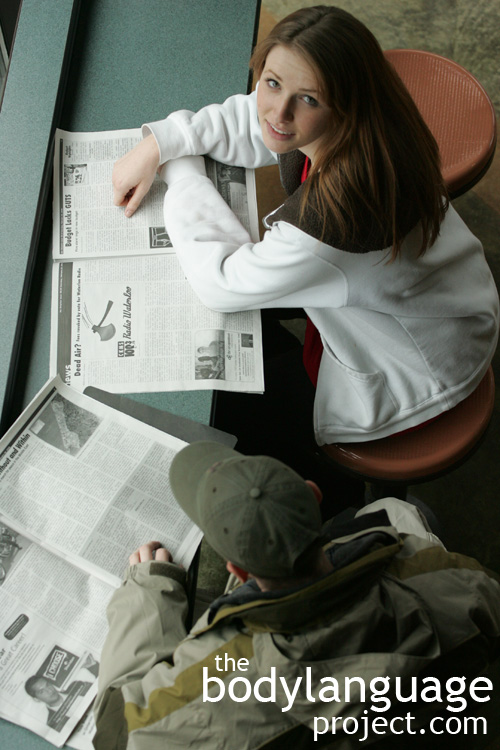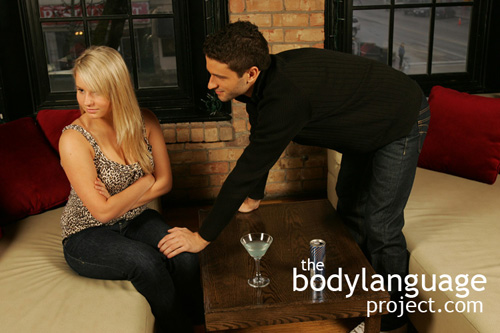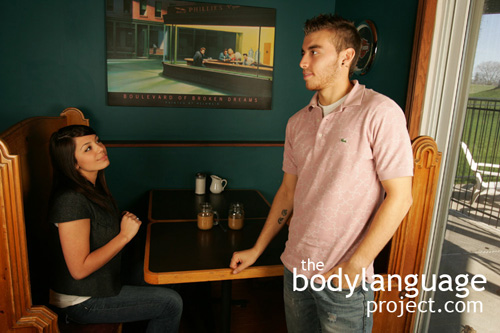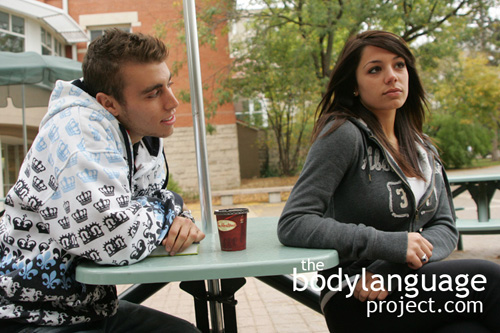Body Language of Standing At Forty-Five Degrees or Casual Corner Sitting Position
 Cue: Standing At Forty-Five Degrees or Casual Corner Sitting Position.
Cue: Standing At Forty-Five Degrees or Casual Corner Sitting Position.
Synonym(s): Standing Obliquely, Sitting Kitty Corner.
Description: When two people stand or sit with their torsos at forty-five degrees to one another forming a v-shape.
In One Sentence: Standing at forty-five degrees is a casual, cooperative, non-intimate standing posture.
How To Use it: Use the forty-five degree standing orientation when you want to make other people comfortable without being confrontational or intimate. The orientation is perfect for business as it is for friends.
By not facing head-on, it allows people to escape easily if they so desire. This will create positive feelings when people are simply sharing information. The same orientation works well when sitting. When people need to work together to get things done and are on the “same team” meeting in this way permits the easy sharing of information.
Men should always approach women at this angle and maintain it when conversing to make them feel more comfortable. Women and most men rarely appreciate being approached blind such as from behind and approaching head-on can be intimidating. Approaching from the side, therefore, is the best possible approach orientation.
To build intimacy on the other hand, if this is desired, should be done by slowly and carefully orienting to a head-on orientation.
Context: a) General b) Business.
Verbal Translation: “I’m comfortable and cooperative but not intimate, so we can both agree to face slightly toward one-another and slightly away from one another.”
Variant: Angular Distance, Standing Square or Cooperative Side-By-Side Seating Arrangement.
Cue In Action: a) The girls huddled up together and exchanged emails. They were both at forty-five degrees to one another. b) The employees were preparing for their presentation and chose the corner of the table, one on each side, to exchange their ideas.
Meaning and/or Motivation: Sitting over the corner of the table is a cooperative sitting orientation as is standing at forty-five degrees. However, most people would state that standing square, face-to-face was the most honest and trustworthy position people orient themselves in while speaking with someone, but they would only be half right. In fact, most Americans stand at forty-five degrees or at oblique angles to one another. Facing someone dead on, is how boxers square off to one another in the pre-show weigh-in or when two men near physical contact at a bar.
The casual corner position is most appropriate to preserve closeness between people, but at the same time offers a partial barrier. The barrier in this case, is the corner of the table. If chairs are directly facing the table, it avoids direct eye contact, but if preferred, the chairs can face one another across the corner of the table to make sharing of information easier. This seating position is unique because it neatly allows for independent thought, but the proximity still permits intimacy.
When standing at forty-five degrees it permits either party to quickly and easily exit the situation merely by walking forward. This creates comfort because it is a demonstration that both parties do not wish to encroach on the other and block them in.
Cue Cluster: This cue defines the context so does not require additional cues. One might watch for other signals of cooperation, however, such as palms up, head nodding, head tilted to the side, leaning in, eye contact and verbal agreement indicators.
Body Language Category: Body pointing, Blading, Intention movements, Seated body pointing.
Resources:
Argyle, M., & Dean, I. Eye contact, distance and affiliation. Sociometry, 1965, 28, 289-304.
Boucher, Michael L. Holzberg, Jules D. (editor). Effect of seating distance on interpersonal attraction in an interview situation. Journal of Consulting and Clinical Psychology. 1972 38(1): 15-19.
Broth, Mathias and Lorenza Mondada. Walking Away: The Embodied Achievement of Activity Closings in Mobile Interaction. Journal of Pragmatics. 2013. 47: 41-58.
http://bodylanguageproject.com/articles/nonverbally-negotiate-conversation-walking-away/
Bania, Amanda E. ; Stromberg, Erin E. Call, Joseph (editor). The Effect of Body Orientation on Judgments of Human Visual Attention in Western Lowland Gorillas.
Journal of Comparative Psychology. 2013. 127(1): 82-90.
Belhiah, Hassan. Tutoring as an embodied activity: How speech, gaze and body orientation are coordinated to conduct ESL tutorial business. Journal of Pragmatics. 2009. 41(4): 829-841.
Cook, M. Experiments on orientation and proxemics. Human Relations, 1970, 23, 61-67.
Clack, B., Dixon, J., & Tredoux, C. (2005). Eating together apart: Patterns of segregation in a multi-ethnic cafeteria. Journal of Community & Applied Social Psychology, 15, 1-16. doi:10.1002/casp.787
Castelli, Luigi ; Carraro, Luciana ; Pavan, Giulia ; Murelli, Elisa ; Carraro, Alessia. The Power of the Unsaid: The Influence of Nonverbal Cues on Implicit Attitudes. Journal of Applied Social Psychology. 2012 42(6): 1376-1393.
Coutts, Larrym. ; Ledden, Maribeth. Nonverbal Compensatory Reactions to Changes in Interpersonal Proximity. The Journal of Social Psychology. 1977 102(2): 283-290.
Chance RMA (1962) An interpretation of some agonistic postures: the role of “cut-off” acts and postures. Symp Zool Soc Lond 8: 71–89.
Danielle Jackson, Erika Engstrom and Tara Emmers-Sommer. 2007. Think Leader, Think Male and Female: Sex vs. Seating Arrangement as Leadership Cues. Sex Roles. 57 (9/10): 713-723.
Felipe, N. Connotations of seating arrangements. Cornell Journal of Social Relations, 1967, 2, 37-44.
Gifford, Robert ; O’Connor, Brian. Nonverbal intimacy: Clarifying the role of seating distance and orientation. Journal of Nonverbal Behavior. 1986 10(4): 207-214.
Gardin, Hershel ; Kaplan, Kalman J. ; Firestone, Ira J. ; Cowan, Gloria A. Lanzetta, John T. (editor). Proxemic effects on cooperation, attitude, and approach-avoidance in a Prisoner’s Dilemma game. Journal of Personality and Social Psychology. 1973. 27(1): 13-18.
Greenberg, J. 1976. The role of seating position in group interaction: a review, with applications for group trainers. Group & Organization Management 1 (3): 310-327.
Haase, Richard F. ; Dimattia, Dominic J. Berdie, Ralph F. (editor). Proxemic behavior: Counselor, administrator, and client preference for seating arrangement in dyadic interaction. Journal of Counseling Psychology. 1970 17(4): 319-325.
Howells, L. T. and S. W. Becker. 1962. Seating arrangement and leadership emergence.
The Journal of Abnormal and Social Psychology 64(2): 148-150.
Hietanen, Jari. Social attention orienting integrates visual information from head and body orientation. Psychological Research.2002 66(3): 174-179.
Harrigan J. and Rosenthal R. Physicians’ head and body positions as determinants of perceived rapport. J. appl. Sot. Psychol. 13, 496, 1983.
Kaminski, Juliane ; Call, Josep ; Tomasello, Michael. Body orientation and face orientation: two factors controlling apes’ begging behavior from humans
Animal Cognition. 2004. 7(4): 216-223.
Kenner, Andrew N. ; Katsimaglis, George. Gender differences in proxemics: taxi-seat choice. Psychological Reports. 1993 72(2): 625(2).
Lawson, Rebecca P. ; Clifford, Colin W. G. ; Calder, Andrew J. About Turn: The Visual Representation of Human Body Orientation Revealed by Adaptation. Psychological Science. 2009. 20(3): 363(9).
Leventhal, G. 1978, Sex and setting effects on seating arrangement. Journal of Psychology. 100: 21-26.
Lott, D. F. and R. Sommer. 1967. Seating arrangements and status. Journal of Personality and Social Psychology 7 (1): 90-95.
Mackinnon, Sean P. ; Jordan, Christian H. ; Wilson, Anne E. Birds of a feather sit together: Physical similarity predicts seating choice. Personality & Social Psychology Bulletin. 2011 37(7): 879(14).
Michelini, RL, Passalacqua, R., & Cusimano, J. 1976. Effects of seating arrangement on group participation. Journal of Social Psychology. 99: 179-186.
Mehrabian, Albert Holzberg, Jules D. (editor). Inference of Attitudes From the Posture, Orientation and Distance of a Communicator. Journal of Consulting and Clinical Psychology. 1968. 32(3): 296-308.
Mehrabian, Albert Deese, James (editor). Significance of posture and position in the communication of attitude and status relationships. Psychological Bulletin. 1969. 71(5): 359-372.
Montgomery, Derek ; Moran, Christy ; Bach, Leslie. The influence of nonverbal cues associated with looking behavior on young children’s mentalistic attributions.
Journal of Nonverbal Behavior. 1996. 20(4): 229-249.
Norum, G.A., Russo, N.J., and Sommer, R. 1967. Seating patterns and group tasks. Source: Psychology in the schools. 4(3): 276-280.
Riess, M. and P. Rosenfeld. 1980. Seating preferences as nonverbal communication: a self-presentational analysis. Journal of Applied Communications Research 8(1): 22.
Remland, Martins. ; Jones, Tricias. ; Brinkman, Heidi. Interpersonal Distance, Body Orientation, and Touch: Effects of Culture, Gender, and Age. The Journal of Social Psychology. 1995 135(3): 281-297.
Robinson, Jeffrey David. Getting Down to Business Talk, Gaze, and Body Orientation During Openings of Doctor-Patient Consultations. Human Communication Research. 1998. 25(1): 97-123.
Straube, Benjamin ; Green, Antonia ; Jansen, Andreas ; Chatterjee, Anjan ; Kircher, Tilo. Social cues, mentalizing and the neural processing of speech accompanied by gestures. Neuropsychologia. 2010. 48(2): 382-393.
Stephenson, G. M. and B. K. Kniveton. 1978. Interpersonal and interparty exchange: an experimental study of the effect of seating position on the outcome of negotiations between teams representing parties in dispute. Human Relations 31(6): 555-566.
Scherer, S. E., & Schiff, M. R. Perceived intimacy, physical distance, and eye contact. Perceptual and Motor Skills, 1973, 36, 835-841.
Scott, J. A. Comfort and seating distance in living rooms: The relationship of interactants and topic of conversation. Environment and Behavior, 1984, 16, 35-54.
Sommer, R. Studies in personal space. Sociometry, 1959, 22,247-260.
Sommer, R. The distance for comfortable conversation: A further study. Sociometry, 1962, 25, 111-116.
Sommer, R. Personal space: The behavioral basis of design. Englewood Cliffs, New Jersey: Prentice Hall. 1969.
Underwood, M. K.. Glares of Contempt, Eye Rolls of Disgust and Turning Away to Exclude: Non-Verbal Forms of Social Aggression among Girls. Feminism & Psychology. 2004 14(3): 371-375
Weiss, M., & Keys, C. The influence of proxemic variables on dyadic interaction between peers. Paper presented at the meeting of the American Psychological Association; Chicago, 1975, August.
Zweigenhaft, R. L. 1976. Personal space in the faculty office: Desk placement and the student-faculty interaction. Journal of Applied Psychology 61 (4): 529-532.






